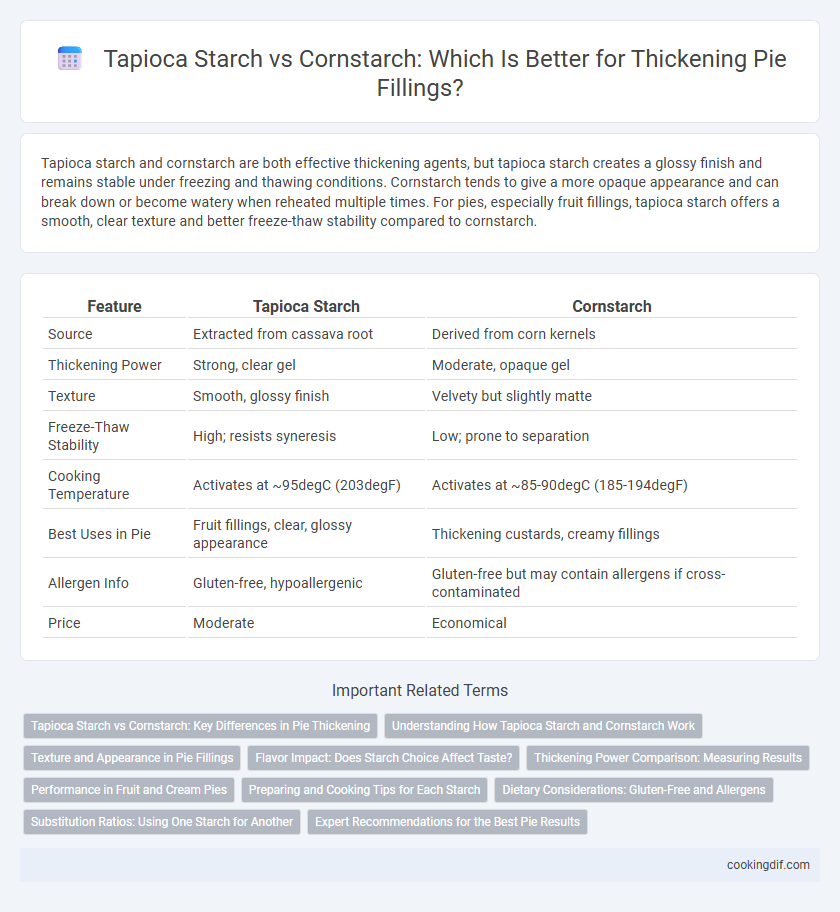Tapioca starch and cornstarch are both effective thickening agents, but tapioca starch creates a glossy finish and remains stable under freezing and thawing conditions. Cornstarch tends to give a more opaque appearance and can break down or become watery when reheated multiple times. For pies, especially fruit fillings, tapioca starch offers a smooth, clear texture and better freeze-thaw stability compared to cornstarch.
Table of Comparison
| Feature | Tapioca Starch | Cornstarch |
|---|---|---|
| Source | Extracted from cassava root | Derived from corn kernels |
| Thickening Power | Strong, clear gel | Moderate, opaque gel |
| Texture | Smooth, glossy finish | Velvety but slightly matte |
| Freeze-Thaw Stability | High; resists syneresis | Low; prone to separation |
| Cooking Temperature | Activates at ~95degC (203degF) | Activates at ~85-90degC (185-194degF) |
| Best Uses in Pie | Fruit fillings, clear, glossy appearance | Thickening custards, creamy fillings |
| Allergen Info | Gluten-free, hypoallergenic | Gluten-free but may contain allergens if cross-contaminated |
| Price | Moderate | Economical |
Tapioca Starch vs Cornstarch: Key Differences in Pie Thickening
Tapioca starch and cornstarch differ significantly in pie thickening properties, with tapioca starch providing a clearer, glossier finish and a chewier texture compared to the more opaque, gel-like consistency from cornstarch. Tapioca starch withstands freezing and reheating better, maintaining its thickening power without becoming watery, making it ideal for pies stored or served cold. Cornstarch thickens quickly at lower temperatures but can break down under prolonged heat, resulting in a thinner filling after baking.
Understanding How Tapioca Starch and Cornstarch Work
Tapioca starch and cornstarch are both effective thickeners used in pie fillings, with tapioca starch derived from cassava roots and cornstarch from corn kernels. Tapioca starch creates a clearer, more glossy finish and remains stable under freezing and reheating, making it ideal for fruit pies, while cornstarch tends to produce a more opaque, matte appearance and may break down when frozen. Understanding these differences helps bakers choose the right starch based on desired texture, clarity, and stability of the pie filling.
Texture and Appearance in Pie Fillings
Tapioca starch creates a clearer, glossy pie filling with a smoother, more elastic texture, enhancing the overall appearance and mouthfeel of fruit pies. Cornstarch tends to produce a more opaque, matte finish and a gel-like, firmer texture that can sometimes appear slightly chalky. Choosing tapioca starch results in a visually appealing, flexible filling, while cornstarch provides a denser, more traditional consistency.
Flavor Impact: Does Starch Choice Affect Taste?
Tapioca starch offers a neutral flavor that preserves the pie filling's original taste, while cornstarch can sometimes impart a slightly chalky aftertaste. Tapioca starch also creates a clearer, glossier finish in fruit pies, enhancing the presentation without altering flavor profiles. Cornstarch thickens more quickly but may mask delicate flavors in custard or cream pies due to its subtle graininess.
Thickening Power Comparison: Measuring Results
Tapioca starch demonstrates higher thickening power than cornstarch, producing a clearer and glossier finish in pies. When measured by weight, tapioca starch typically requires less quantity to achieve the same viscosity compared to cornstarch. Its superior stability under freezing and thawing conditions also makes tapioca starch a preferred choice for pie fillings needing consistent texture.
Performance in Fruit and Cream Pies
Tapioca starch offers superior performance in fruit pies by creating a clearer, more glossy filling that resists thinning and maintains a smooth texture during baking and cooling. Cornstarch tends to produce a more opaque, gel-like consistency that can break down or become watery over time, especially in acidic fruit fillings. For cream pies, tapioca starch provides a silkier mouthfeel and greater stability, preventing weeping and separating compared to cornstarch's tendency to curdle under heat.
Preparing and Cooking Tips for Each Starch
Tapioca starch absorbs less water than cornstarch, making it ideal for fruit pies where a glossy, translucent filling is desired without excessive thickening. Use tapioca starch by mixing it with cold water before adding to the hot filling, then simmer gently to activate its thickening properties without breaking down. Cornstarch requires thorough cooking to eliminate its raw flavor and achieves maximum thickening when boiled; it works best in creamy fillings and should be added gradually to avoid clumping.
Dietary Considerations: Gluten-Free and Allergens
Tapioca starch is naturally gluten-free and hypoallergenic, making it an excellent thickening option for pies suited to those with gluten intolerance or allergies. Cornstarch is also gluten-free but may cause issues for individuals with corn allergies. Choosing tapioca starch ensures a safe, allergen-friendly alternative while providing a glossy texture ideal for fruit pie fillings.
Substitution Ratios: Using One Starch for Another
Tapioca starch and cornstarch have different thickening strengths, requiring specific substitution ratios for successful pie filling consistency. When substituting tapioca starch for cornstarch, use 1 1/3 tablespoons of tapioca starch for every 1 tablespoon of cornstarch to achieve similar thickness. For replacing tapioca starch with cornstarch, increase the amount to 3/4 tablespoon of cornstarch per 1 tablespoon of tapioca starch to maintain optimal texture in the pie filling.
Expert Recommendations for the Best Pie Results
Tapioca starch provides a clear, glossy finish and maintains a stable texture during baking, making it ideal for fruit pies that require a sturdy filling. Experts recommend cornstarch for cream or custard pies due to its smooth consistency and neutral flavor that thickens without altering the taste. For optimal pie results, use tapioca starch in recipes with high moisture and cornstarch in recipes where a soft, creamy texture is desired.
Tapioca starch vs cornstarch for thickening Infographic

 cookingdif.com
cookingdif.com